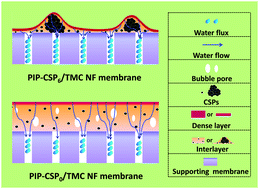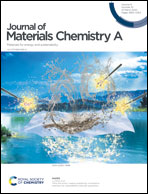An ultrahighly permeable-selective nanofiltration membrane mediated by an in situ formed interlayer†
Abstract
Nanofiltration (NF) membranes with high permeability and selectivity are urgently needed to reduce energy consumption and improve separation efficiency in desalination and wastewater treatment. Herein, an ultrahighly permeable-selective NF membrane mediated by an in situ formed interlayer is designed and prepared through chitosan (CS) assisted interfacial polymerization of piperazine (PIP) in water with trimesoyl chloride (TMC) in n-hexane. CS exists in the form of free molecules and nanoparticles (CSPs) and in situ forms an interlayer due to its slower diffusion rate compared with PIP during interfacial polymerization and mediates the structure and performance of the NF membrane. Through controlling the CS concentration and aging time of CSPs in an aqueous amine solution, the NF membrane surface morphology can be systematically tuned from nodular to vermicular and to a convex structure, while the thickness of the polyamide layer obtained can be maintained at about 20 nm. The resulting NF membrane shows an unprecedented separation performance with a pure water permeance up to 45.2 L m−2 h−1 bar−1, equivalent to about 5-fold that of the control PIP/TMC NF membrane, while maintaining a Na2SO4 rejection of 99.3%. The superior performance is attributed to a synergistic effect of the reduced thickness of the polyamide layer, increased special surface area with negative charges, and low-resistance water nanochannels in the interlayer. This work provides a cost-effective and simple route to fabricate ultrahighly permeable-selective NF membranes.



 Please wait while we load your content...
Please wait while we load your content...